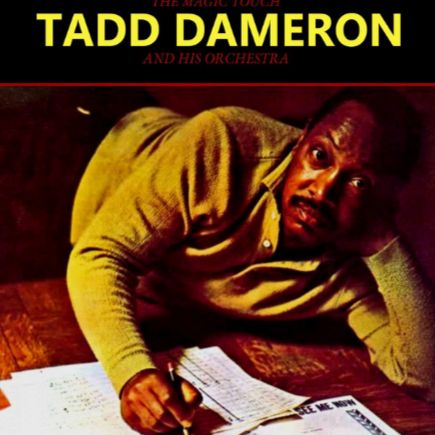If You Could See Me Now: élégie bebop et transition historique
Composée en 1946 par le pianiste Tadd Dameron, figure essentielle du bebop, If You Could See Me Now marque un tournant dans l’histoire du jazz vocal. Créée pour Sarah Vaughan, fidèle collaboratrice du compositeur, la chanson bénéficie également de paroles signées Carl Sigman et, en partie, de Vaughan elle-même. Dès les premières mesures, elle impose un climat intime et suspendu, porté par une mélodie enveloppante et une écriture harmonique d’une rare sophistication.
Dameron, influencé par les compositeurs classiques européens autant que par les pionniers du jazz moderne, tisse ici une trame sonore à la fois élégante et émotive, où chaque accord semble chargé d’un profond sentiment de nostalgie. Ce qui distingue ce morceau, c’est cette alliance subtile entre lyrisme expressif et complexité structurelle — un équilibre parfaitement incarné par l’interprétation de Vaughan, à la fois retenue, audacieuse et bouleversante.
If You Could See Me Now incarne un moment charnière: celui du passage du swing au bebop. Dans l’Amérique de l’après-guerre, une nouvelle génération de musiciens s’affranchit des conventions du swing pour inventer un langage plus libre, plus nerveux, plus personnel. Dameron s’inscrit pleinement dans ce mouvement, proposant ici une œuvre qui conjugue innovation harmonique et sensibilité mélodique.
L’art de Dameron dans toute sa maturité
Enregistrée à New York le 16 avril 1962 pour l’album The Magic Touch, cette version de If You Could See Me Now marque l’un des derniers grands gestes orchestraux de Tadd Dameron, qui y déploie une sensibilité harmonique et une science de l’arrangement qui ont profondément influencé le jazz moderne.
Dans cet enregistrement de maturité, Dameron ne joue pas lui-même, mais dirige une formation exceptionnelle réunissant quelques-unes des figures les plus respectées de l’époque: Clark Terry, Charlie Shavers et Joe Wilder aux trompettes, Johnny Griffin au saxophone ténor, Bill Evans au piano, Ron Carter à la contrebasse et Philly Joe Jones à la batterie, avec la voix de Barbara Winfield.
L’interprétation, d’une grande retenue expressive, met en valeur l’élégance de l’écriture et l’art du phrasé collectif. Les lignes de cuivres, subtilement agencées, prolongent l’émotion sans jamais la forcer. La rythmique, souple et nuancée, crée un climat feutré où chaque respiration compte. La présence de Bill Evans apporte une touche impressionniste à l’ensemble, en parfaite affinité avec le lyrisme discret de la composition.
If You Could See Me Now: elegía bebop y transición histórica
Compuesta en 1946 por el pianista Tadd Dameron, figura esencial del bebop, If You Could See Me Now marca un punto de inflexión en la historia del jazz vocal. Creada para Sarah Vaughan, habitual colaboradora del compositor, la canción cuenta también con letra de Carl Sigman y, en parte, de la propia Vaughan. Desde los primeros compases, establece una atmósfera íntima y suspendida, sostenida por una melodía envolvente y una escritura armónica de excepcional sofisticación.
Dameron, influido tanto por los compositores clásicos europeos como por los innovadores del jazz moderno, teje aquí una textura sonora elegante y emotiva, en la que cada acorde parece cargado de una profunda nostalgia. Lo que distingue a esta pieza es su sutil equilibrio entre lirismo expresivo y complejidad estructural, encarnado con perfección en la interpretación de Vaughan: contenida, audaz y conmovedora.
If You Could See Me Now representa un momento clave: el paso del swing al bebop. En la América de la posguerra, una nueva generación de músicos buscaba liberarse de las convenciones del swing para explorar un lenguaje más libre, más nervioso y más personal. Dameron se inscribe de lleno en esta dinámica, ofreciendo aquí una obra que combina innovación armónica con una intensa sensibilidad melódica.
El arte de Dameron en su plena madurez
Grabada en Nueva York el 16 de abril de 1962 para el álbum The Magic Touch, esta versión de If You Could See Me Now representa uno de los últimos grandes logros orquestales de Tadd Dameron, quien despliega aquí una sensibilidad armónica y un dominio del arreglo que han influido profundamente en la evolución del jazz moderno.
En esta grabación de madurez, Dameron no toca personalmente, pero dirige una formación excepcional que reúne a algunas de las figuras más respetadas de la época: Clark Terry, Charlie Shavers y Joe Wilder en las trompetas, Johnny Griffin en el saxofón tenor, Bill Evans al piano, Ron Carter al contrabajo y Philly Joe Jones en la batería, con la voz de Barbara Winfield.
La interpretación, de una contención expresiva notable, destaca por la elegancia de la escritura y el arte del fraseo colectivo. Las líneas de metales, sutilmente elaboradas, prolongan la emoción sin exagerarla. La sección rítmica, flexible y matizada, crea un clima íntimo donde cada pausa tiene peso. La presencia de Bill Evans añade un matiz impresionista al conjunto, en perfecta armonía con el lirismo contenido de la composición.
If You Could See Me Now: elegia bebop e svolta storica
Composta nel 1946 dal pianista Tadd Dameron, figura centrale del bebop, If You Could See Me Now segna una svolta nella storia del jazz vocale. Scritta per Sarah Vaughan, collaboratrice abituale del compositore, la canzone porta anche la firma di Carl Sigman e, in parte, della stessa Vaughan. Fin dalle prime battute, impone un’atmosfera intima e sospesa, sostenuta da una melodia avvolgente e da una scrittura armonica di rara raffinatezza.
Dameron, influenzato sia dai compositori classici europei che dai pionieri del jazz moderno, tesse qui una trama sonora elegante ed emotiva, in cui ogni accordo sembra carico di un profondo senso di nostalgia. Ciò che distingue questo brano è l’equilibrio sottile tra lirismo espressivo e complessità strutturale — un equilibrio incarnato alla perfezione dall’interpretazione di Vaughan, al tempo stesso misurata, audace e toccante.
If You Could See Me Now rappresenta un momento cruciale: il passaggio dallo swing al bebop. Nella società americana del dopoguerra, una nuova generazione di musicisti si emancipa dalle convenzioni dello swing per esplorare un linguaggio più libero, nervoso e personale. Dameron aderisce pienamente a questo spirito, offrendo un’opera che coniuga innovazione armonica e sensibilità melodica.
L’arte di Dameron nella sua piena maturità
Registrata a New York il 16 aprile 1962 per l’album The Magic Touch, questa versione di If You Could See Me Now rappresenta uno degli ultimi grandi gesti orchestrali di Tadd Dameron, che vi dispiega una sensibilità armonica e una maestria nell’arrangiamento che hanno lasciato un segno profondo nella storia del jazz moderno.
In questa registrazione di piena maturità, Dameron non suona direttamente, ma dirige una formazione eccezionale composta da alcune delle figure più rispettate dell’epoca: Clark Terry, Charlie Shavers e Joe Wilder alle trombe, Johnny Griffin al sax tenore, Bill Evans al pianoforte, Ron Carter al contrabbasso e Philly Joe Jones alla batteria, con la voce di Barbara Winfield.
L’interpretazione, caratterizzata da un’espressività trattenuta, mette in luce l’eleganza della scrittura e l’arte del fraseggio collettivo. Le linee dei fiati, orchestrate con finezza, estendono l’emozione senza mai forzarla. La sezione ritmica, flessibile e sfumata, crea un’atmosfera ovattata in cui ogni respiro ha significato. La presenza di Bill Evans aggiunge un tocco impressionista all’insieme, in perfetta sintonia con il lirismo discreto della composizione.
If You Could See Me Now: bebop elegy and historical turning point
Composed in 1946 by pianist Tadd Dameron, a key figure in bebop, If You Could See Me Now marks a turning point in the history of vocal jazz. Written for Sarah Vaughan, Dameron’s frequent collaborator, the song features lyrics by Carl Sigman and, in part, by Vaughan herself. From the opening bars, it creates an intimate, suspended atmosphere, shaped by an enveloping melody and a remarkably sophisticated harmonic design.
Dameron—deeply influenced by both European classical composers and the avant-garde jazz innovators of his time—weaves a sonic fabric that is at once elegant and emotional, where every chord seems infused with longing and nostalgia. What sets this piece apart is its delicate balance between expressive lyricism and structural complexity, a balance Vaughan embodies with restraint, boldness, and deep emotional power.
If You Could See Me Now captures a pivotal moment: the shift from swing to bebop. In postwar America, a new generation of musicians sought to break free from swing’s conventions to explore a more personal, restless, and harmonically adventurous language. Dameron fully embraced this movement, offering here a work that fuses harmonic innovation with melodic sensitivity.
Dameron’s art at full maturity
Recorded in New York on April 16, 1962, for the album The Magic Touch, this version of If You Could See Me Now stands as one of Tadd Dameron’s final major orchestral statements. In it, he displays a refined harmonic sensibility and an exceptional command of arrangement that left a lasting impact on modern jazz.
In this mature recording, Dameron does not perform himself, but leads an extraordinary ensemble featuring some of the most respected figures of the time: Clark Terry, Charlie Shavers, and Joe Wilder on trumpets, Johnny Griffin on tenor saxophone, Bill Evans on piano, Ron Carter on bass, and Philly Joe Jones on drums, with vocals by Barbara Winfield.
The interpretation, marked by expressive restraint, highlights the elegance of Dameron’s writing and the subtlety of collective phrasing. The brass lines, delicately arranged, extend the emotion without overstatement. The rhythm section, supple and nuanced, creates a hushed atmosphere where every breath matters. Bill Evans’s presence adds an impressionistic touch, perfectly attuned to the understated lyricism of the piece.


